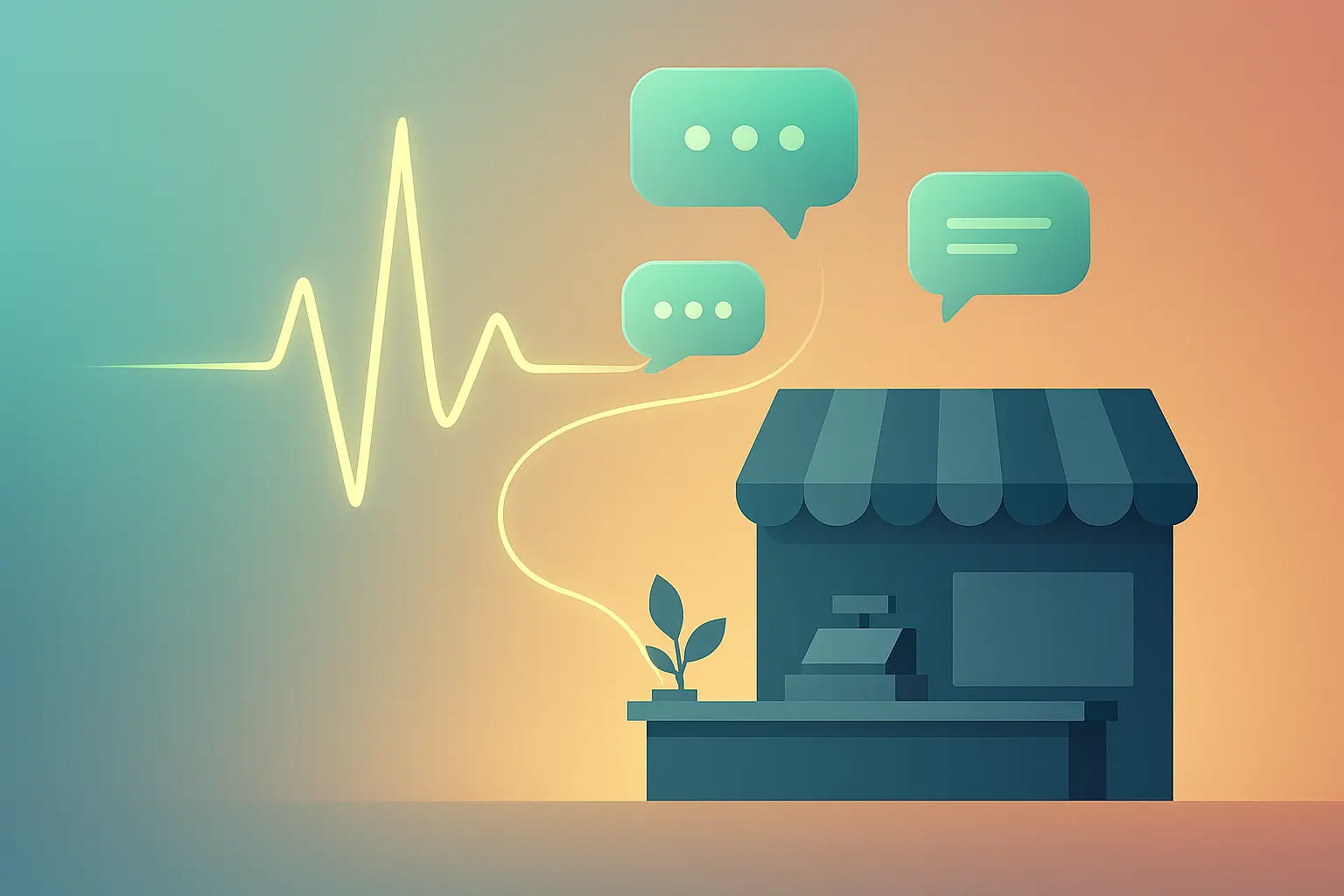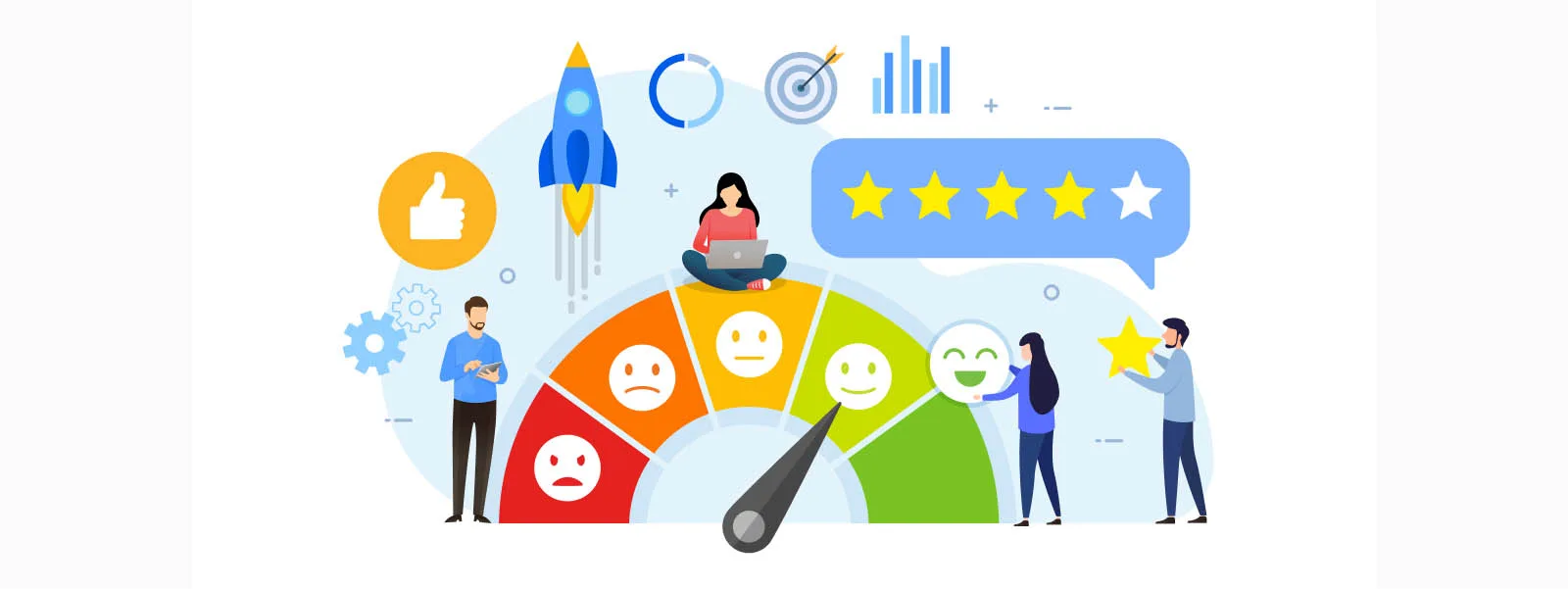Omnichannel Customer Journey: A Complete Guide
- May 11, 2022
- 27 mins read
- Listen

Today, customers are engaging with brands through more channels and in more ways than ever before, often using multiple channels at a time. Google Research indicates that 90% of multi-device owners switch between devices daily, averaging three devices to complete a task. Customers expect a seamless experience, regardless of the device or channel they use. They are more likely to favor brands that prioritize the customer journey over those that deliver frustrating service experiences.
This is where omnichannel customer journey mapping becomes essential. It allows businesses to visualize and connect all customer touchpoints, whether online or offline and identify gaps that need attention. According to Omnisend data, omnichannel marketing can drive almost six times the sales compared to single-channel marketing.
As the number of customer touchpoints—such as live chat, social media platforms, emails, and phone calls—continue to grow, staying on top of these channels as well as proactively engaging with customers to offer instant assistance becomes increasingly complex. Simply launching an omnichannel campaign doesn’t ensure success. You also need to understand the customer journey to build an effective omnichannel roadmap.
In this blog, we’ll provide a comprehensive understanding of the omnichannel customer journey, including its benefits, key strategies to follow, and real-life examples to guide you in implementing it effectively.
What is Omnichannel Customer Journey?
An omnichannel customer journey is all about covering every interaction a customer has with your business across various channels and touchpoints, including customer support, social media platforms, websites, mobile apps and in-store experiences.
How to create a better omnichannel customer journey? Let me explain with an example.
Imagine a customer browsing Instagram in her free time. She comes across an ad on Instagram for a beautiful dress and clicks on it, which directs her to the retailer’s website. On the website, she can explore more images, check the size chart, and read fabric details, along with customer reviews praising the dress. However, she discovers that her size is not available online. She then uses the live chat feature to connect with a customer service agent. The agent checks inventory at a nearby physical store, finds the dress in her size, and reserves it for pick up the next day.
In this example, the omnichannel customer journey includes several touchpoints with the brand: the Instagram ad, the website, live chat, and the physical store. The customer seamlessly transitions from one touchpoint to the next, ultimately leading to a smooth and successful purchase.
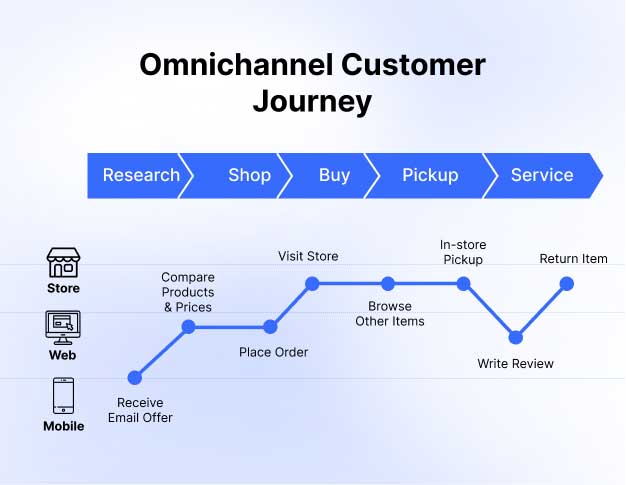
Why Omnichannel Customer Journey for Your Business?
Why opt for it? An omnichannel customer journey is important for businesses today because it aligns with the way customers interact with brands across multiple channels and touchpoints. Here’s why implementing an omnichannel strategy can be beneficial:
- Clear Perspective of Customer Journey: Having an omnichannel model for customer journey gives businesses a bird’s-eye view of every stage. It streamlines all the interactions across multiple channels under one platform and gives insights into the actions for improving your business.
- Increase Customer Retention: Focusing on omnichannel customer journey allows customers to reach out to a brand via their preferred channels with a smooth transition in the same interaction. It levels up satisfaction rate and acts as an effective customer retention strategy.
- Higher Customer Lifetime Value (CLTV): An omnichannel customer journey model simplifies getting in touch with the company and delivers consistent experience all the time that eventually increases customer lifetime. Omnichannel customers are 30% more valuable to your business over the course of their lifetime.
- Surge Customer Satisfaction: The seamless and personalized omnichannel experiences you deliver based on user mapping lead to higher levels of customer satisfaction. As customers are being heard and responded to in a way that feels right for them. When customer satisfaction increases, so does your company’s revenue.
Key Components of the Omnichannel Customer Journey
An omnichannel customer journey map involves more than just having a presence across various platforms; it’s also about delivering a consistent and unified experience to the customers throughout their entire interaction with your brand. While crafting outstanding omnichannel experiences may seem complex, but it’s not impossible. Here are the essential components you need to create a seamless and engaging omnichannel customer journey from beginning to end.
1. Channel Integration
You need to integrate all sales channels—whether it’s websites, mobile apps, social media platforms, or physical stores—to ensure a unified and consistent brand experience. Customers should be able to navigate smoothly between channels without facing any inconsistency in communications related to product details, pricing, promotions etc.
2. Effortless Customer Journey
Your customers should be able to start their shopping journey on one channel and easily continue on another, without losing progress or encountering any inconsistencies on information or communication.
For instance, a customer might browse products on a social media platform like Facebook, add items to their cart on the company’s website, and finally pay for those products in a physical store. To ensure a smooth transition and uninterrupted shopping experience, retailers need to synchronize customer information, cart contents, and preferences across all channels.
3. Personalization
It plays a crucial role across the entire customer life cycle. According to McKinsey, personalization not only increases the likelihood of purchase but also leads 78% of consumers to recommend brands that offer personalized engagements and make repeat purchases.
Today’s customers expect brand interactions that are customized to their individual needs and preferences. With omnichannel marketing, you can harness customer data from all channels to personalize your content, recommendations, and promotions. This results in a customer base that feels appreciated and is more inclined to engage with your brand.
4. Adding the Technology
For a seamless omnichannel experience, having a robust tech infrastructure is essential, supported by advanced platforms like CRMs and AI chatbots. A CRM system is helpful for managing your sales funnel, as it holds key customer data like purchase history, preferences, and past interactions.
AI technology further enhances this by personalizing omnichannel customer journeys at scale. AI chatbots not only automates customer service but also improves various business operations, leading to higher sales conversions and better customer satisfaction. For example, if a customer leaves an online cart behind, you can automatically send a reminder email with his saved items or a personalized discount code to encourage him to complete the purchase.
How to Create a Better Omnichannel Customer Journey
In order to deliver a great omnichannel customer experience there are different strategies. Implementing the right strategy, siloed engagements can be avoided. Businesses that invest in omnichannel customer service plans witness higher customer satisfaction and retention.
Here is a quick list of the strategic ways of creating a successful omnichannel customer experience management model.
1. Research Extensively on Buyer Personas
“Personas are the starting point,” says Michael Hinshaw, CX strategist.
Because a journey map is the story of a customers’ experience – it explains what happens along the way. Personas represent the customers whose journeys we are mapping.
Buyer personas play an important role in the overall customer journey mapping process, it is vital that organizations create valuable personas that provide a robust platform upon which to build the maps.
A good customer persona typically consist of five parts:
- Goals & Objectives – What is your persona trying to do, why and by when?
- Motivations – What are the key triggers and hindrances? What influences their thinking?
- Behaviors – Where do they find information? Is your persona spontaneous or do they research and plan every detail? What media channels do they like to use?
- Profile – Think about your persona’s demographics. It can also be useful to think about variables like price sensitivity, confidence with technology and amount of leisure time and whether your persona over- or under-indexes on them.
- Quotes & Photos – Bring your personas to life. It is important that they are stereotypes that feel real so give them a name, add comments captured through research and photos of what they look like.
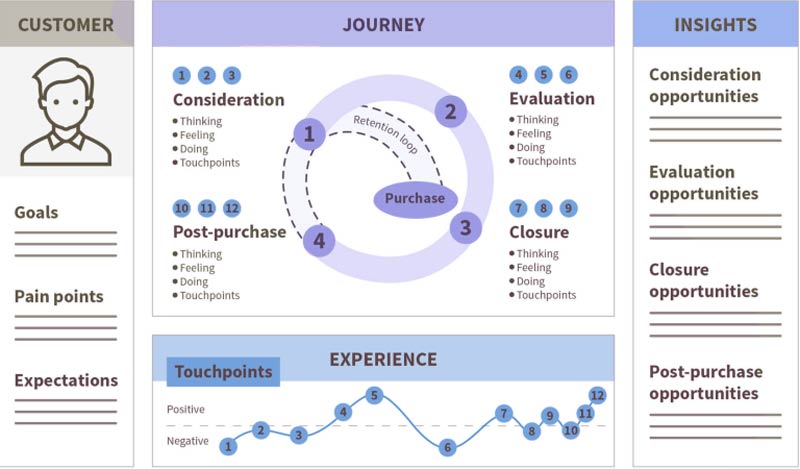
The best part of a buyer’s persona is that they help in making omnichannel customer journeys smoother in the following ways:
- Enhance value propositions that align with the customer expectations.
- Boost business profits by providing customers with what exactly they are looking for.
- Provide a better understanding of buyers, their needs, and how to fix them.
- Accelerate lead generation by aligning teams around a customer-centric vision.
2. Map Your Customer Journey
Nearly 70% of online shoppers abandoned their cart. Why does a customer spend hours adding products to their cart just to close the tab?
It is likely because you lack a clear grasp of the customer’s journey to purchasing your product or service. You also fail to understand the difference between a buyer journey vs customer journey. The omnichannel customer journey includes every moment a customer interacts with your brand across every touchpoint.
Documenting these moments sequentially yields a sort of map, known as a customer journey map, that can be used to better understand the obstacles customers face in achieving their goals.
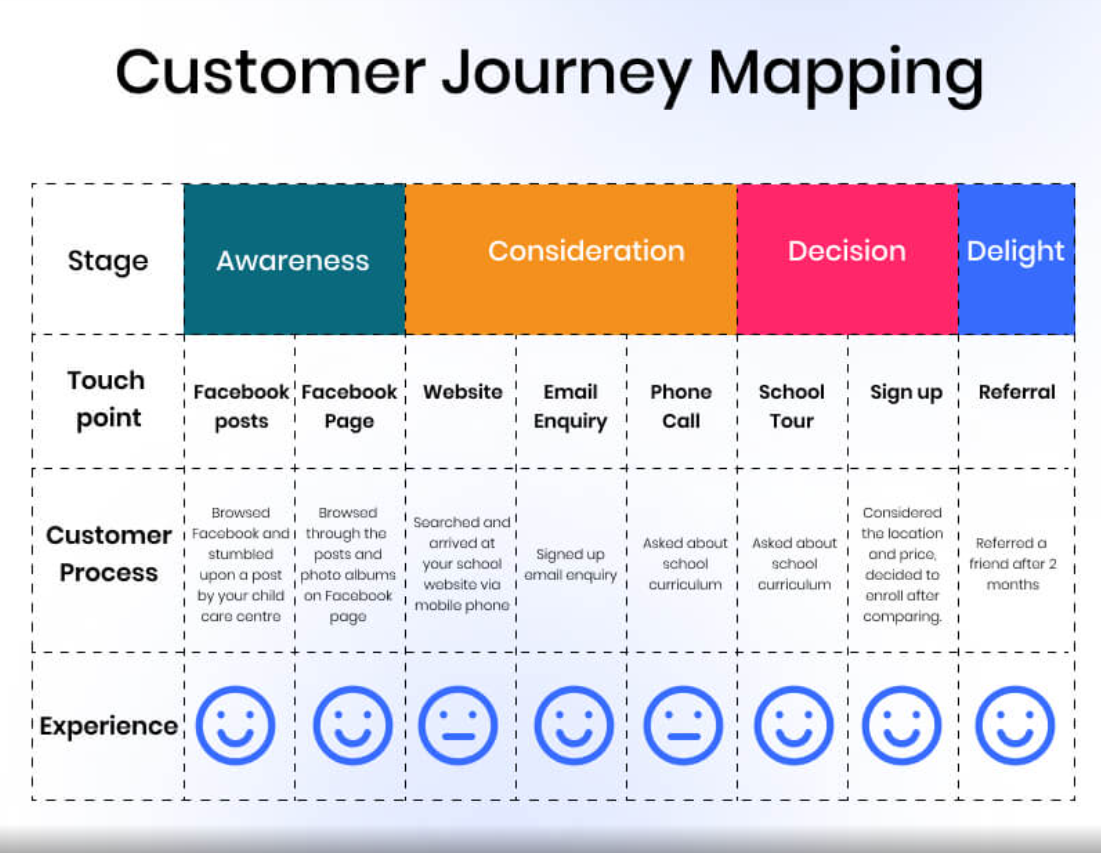
Customer journey maps are often divided into distinct phases to help differentiate between otherwise similar types of interactions.
The different phases include:
- Awareness and acquisition: This phase is all about discovery. Customers coming across an ad for your business, visiting your website, calling your contact center all qualify as part of the awareness phase. Customers who commit to making a purchase enter into the acquisition phase, which then connects with the onboarding phase.
- Onboarding and engagement: This phase involves all interactions meant to guide new customers via the purchasing process, including details on how to get the most out of your product or service. It leads to the engagement phase which focuses on interacting closely with customers once they are more acquainted with your brand.
- After-purchase support: This customer journey phase includes the interactions that happen after a customer’s purchase such as reaching out to customer support via phone, visiting your company’s self-support portal or knowledge base, and contacting customer service via email, social media, or any other channel.
3. Identify the Touchpoints Most Preferred
Touchpoints are the key to understanding your customer’s journey. They are basically the place where customer interactions occur.
On an average it takes seven interactions with your brand before the final purchase. Based on such interactions, customers usually create a first impression of the overall brand.
By identifying customer touchpoints, it’s possible to cultivate loyalty and improve customer experience. When you map your customer journey across multiple channels and connect them, it helps you understand customers and their requirements better.
It also enables you to gain a better understanding on how your customers are feeling at each stage of the buying process and through different channels.
How identifying touchpoints help to optimize your omnichannel customer journey model?
- Understand customers and engage them the way they want – learning about the preferred touchpoints helps to be actively available across the channels for real time assistance.
- Personalize your interaction with clients – You can personalize your interaction at the identified touchpoints and create excellent customer service experience examples.
4. Employ Right Tools for Omnichannel Customer Engagement
A customer ought to spend more when there is a significant number of channels available along their customer journey. Ideally, it is difficult to deliver seamless experiences across diverse touchpoints without the right technology to enable it. Moreover, building the right technology model to provide excellent experience across channels is vital to deliver hassle-free omnichannel user experience.
For any customer to be able to switch between the mobile app and chatbot conversation conveniently, businesses need to use the right digital tools that allow data flow at ease in real-time, to serve customers on their preferred touchpoints.
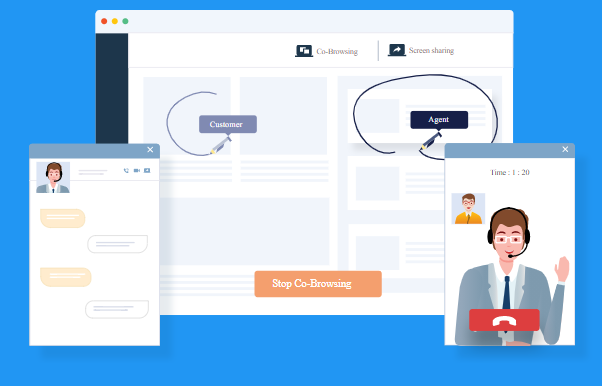
Some tools that can be used at different touchpoints for creating a great omnichannel customer journey model.
- Chatbots – These AI chatbots can be built and deployed easily to engage customers 24×7 and provide real time answers for simple queries.
- Live chat – Deliver real time assistance to the sales and support related queries with live chat and boost customer satisfaction.
- Visual engagement tools – Using the co-browsing tool to collaborate with customers in real time helps in guiding through complex issues and improve first contact resolution (FCR). With a video enabled call center, you can identify issues faster and deliver personalized solutions.
The above mentioned digital engagement tools empower support agents to provide real time response, and effective solutions. You can also strengthen your customer relationships and increase brand loyalty.
5. Scrutinize Customer Feedback Regularly
Getting a handle on how customers view your product, support, and the company is invaluable.
Customer feedback is essential to guide and inform your decision making and influence innovations and changes to your product or service. It brings in golden opportunities that can help you to improve the omnichannel customer journey.
It is also essential for measuring customer satisfaction among your existing customers.
Delivering superior service means delivering real time support by being where your customers are and giving them an easy way to share feedback.
Omnichannel approach empowers brands to engage with customers via every channel and capture feedback at every touchpoint. The different ways to ask for customer feedback are website, social media, emails, in-app, reviews, etc.
Here is how analyzing customer feedback can help to set successful omnichannel customer journey example
- Rightly use feedback to develop an in-depth understanding of customers (their needs, pain points, wants, expectations) to serve them better.
- Implement a proper system to help you collect feedback, analyze it, and act on a regular basis.
- Reduce friction significantly and resolve your customers’ complex problems and challenges.
6. Balance Automation & Human Support Wisely
Another important aspect of omnichannel customer experience is balancing automation and human understanding in the balance proportion.
Customers expect brands to understand them with both intelligent technology along with empathetic human experiences.
Choosing the right approach needs a comprehensive understanding of using live chat vs chatbot by learning the pros and cons of both channels.
Having a balanced support approach of both options manages the resources on priority tasks.
It is recommended to use chatbots as the primary contact for customer interaction and use human support for complex conversations.
Designing both for a great customer service experience helps to maintain the right balance that eventually turns to be the real differentiator for the brand.
Figuring out when a conversation needs to shift from a bot to a human is how the balance manifests – For example, knowing when to please the angry customer with an apology versus an offer or so.
7. Perform a Thorough Gap Analysis
Offering customers seamless, consistent, omnichannel experiences at all customer journey stages is essentially table stakes. Performing a comprehensive analysis to identify the gaps in fragmented experiences is a vital part of improving omnichannel customer experience. Brands putting efforts to create a seamless omnichannel customer journey is always a work in progress as customer habits keep evolving.
Today, social media is one of the major platforms to provide immediate assistance to customers while also scoring brownie points in full view of the entire customer community. Evaluating the gaps will give you valuable insights into what actually your customers are looking for and take the right action steps of improvement to deliver a better omnichannel customer journey experience.
It is recommended to keep a close eye for any data related gaps between various channels, as that may force customers to refer to different sources or channels.
8. Implement Customer Journey Analytics
Customer Journey Analytics allows you to bring your customer data from any channel you choose — both online and offline.
Businesses are increasingly benefiting from customer journey analytics across marketing and customer experience, as the results are real, immediate and have a lasting effect. Customer journey analytics is a whole new approach to analytics that involves having a journey-based mindset and becoming customer-obsessed. Learning how to choose the best journey analytics platform is just the beginning.
The most powerful benefit of using customer journey analytics is that it connects individual customer behavior to important quantitative metrics and KPIs that you and your business are measured by. The key lies in selecting the right metrics and KPIs to monitor and improve, based on the insights generated by your journey analytics platform. Some key customer metrics are:
- Net Promoter Score (NPS)
- Customer Satisfaction Score (CSAT)
- Customer Effort Score (CES)
9. Provide Self Service Options
Research shows businesses lose nearly $75 billion a year in revenue due to poor customer service.
Creating self-service options can be highly effective during the customer journey. Hence businesses are investing to develop self-service portals for improving the overall brand experience. As customers expect immediate answers to their queries. In fact, response time is the most important attribute of the customer journey experience.
Self-service portals provide customers with instant access to information and save time and business resources. 67% of customers prefer to use self-service options instead of speaking with a company representative.
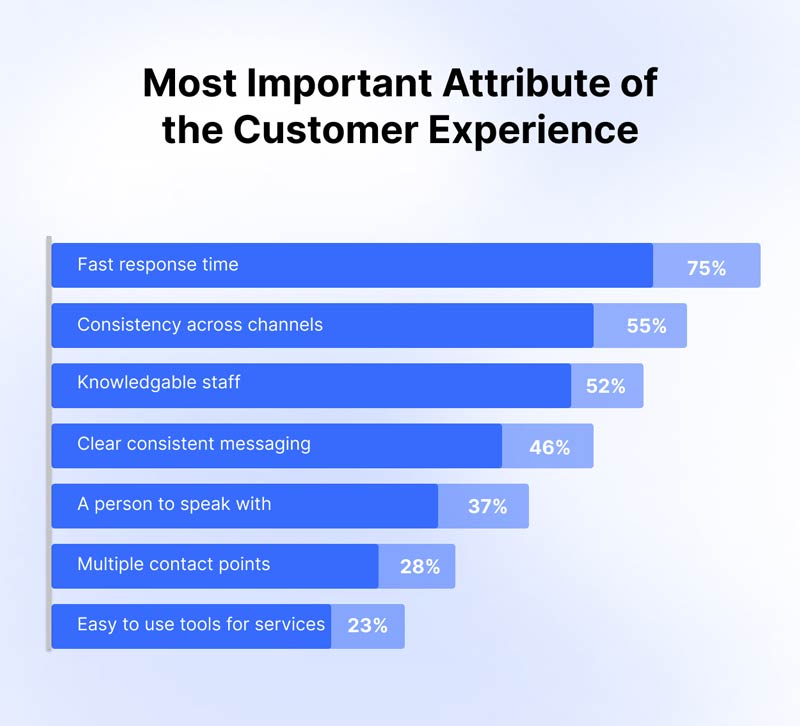
Businesses can create tutorials, manuals, how-to videos to help customers to solve their problems on their own.
Here is how self service portals are an important part of the omnichannel customer journey.
- Use personalized information – Such portals can maintain a record of the products or services purchased and display what is relevant to them. You can identify customer issues and take key steps to address them.
- More positive recommendations – The self service portals help to strengthen brand credibility by creating positive client interactions.
- Educate customers – These portals also help to broaden your customers’ knowledge & skills they require for solving other similar issues in the future.
10. Offer a Safe Customer Experience
Omnichannel retailers had to evolve dramatically during the peaks of COVID-19 to comply with public safety policies to raise customer confidence in shopping across all channels. As the market looks beyond the pandemic, omnichannel customers not only want an excellent customer experience, but they also want a safe customer experience.
Focusing on omnichannel retailers and their customers, the latest research on safe customer experience (Safe CX) provides a framework for enhancing customer safety and overall CX in post-pandemic omnichannel retailing.
As illustrated in the SafeCX framework below, the study identified fourteen safety elements in an omnichannel retail strategy.
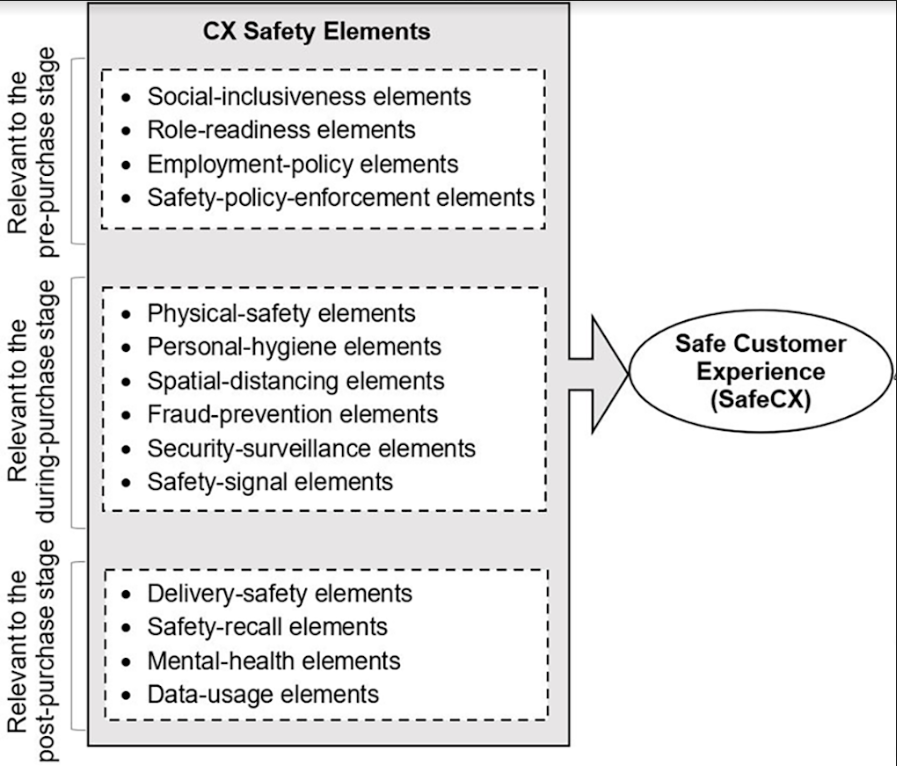
These safety elements are classified into three broad categories: safety elements relevant to CX at the pre-purchase stage, during-purchase stage and the post-purchase stage of the customer journey across all channels.
The SafeCX framework positions the fourteen safety elements into relevant categories:
- Four elements are relevant to the CX at the pre-purchase stage of the customer journey: social inclusiveness, role readiness, employment policy and safety policy enforcement.
- Six elements are relevant to the during-purchase stage of the customer journey: physical safety, personal hygiene, spatial distancing, fraud prevention, security surveillance and safety signal.
- The remaining four elements are relevant to the post-purchase stage of the customer journey: delivery safety, safety recall, mental health and data usage.
Retail managers could focus on the fourteen safety elements when designing a seamless and safe omnichannel customer journey.
Best Practices to Build an Omnichannel Customer Journey Map
To design an effective omnichannel customer journey map, start by understanding the various touchpoints your customers use to interact with your brand. With this knowledge, you can work towards providing a seamless and consistent experience across all channels. Here are some best practices to guide you.
1. Centralize All Your Customer Data in One Place
The first priority is to centralize all your data. When you have all this information consolidated in one location and can be easily accessible by your entire customer-facing team, you can proceed with the other steps. For gathering all your data, you’ll need two key components: a robust contact center platform that supports an omnichannel customer experience and seamless integrations between your customer data tools, such as a CRM or CDP.
2. Select Easy to Use Omnichannel Platform
Marketers and support agents don’t have the luxury of spending hours learning a new product, so it’s essential to choose one that’s user-friendly. When selecting an omnichannel platform, look for an intuitive interface that allows you to easily map and visualize the customer journey across all channels.
Things to keep in mind:
- Choose a platform with a clean layout and straightforward navigation.
- Look for a platform that offers clear, guided tutorials or onboarding to help users get up to speed quickly.
- Take advantage of free trials or demo versions to test the platform’s usability.
- Opt for a platform that allows you to customize dashboards and workflows according to your team’s specific needs.
3. Mobile Optimization
Your users spend more time on their phones and expect the convenience of managing their online shopping from anywhere. To capitalize on this trend, it’s essential to optimize your omnichannel customer journey for your mobile users as well. Ensure your website, emails, apps, and other digital assets are mobile-friendly to drive higher conversions.
Pro Tips:
- Design your mobile app with a simple and intuitive interface.
- Update your mobile app regularly with new features and improvements based on user feedback.
- Use responsive email templates that look great on mobile devices, with clear call-to-action buttons that are easy to tap.
- Offer mobile-friendly customer support options like live chat or AI-driven chatbots to assist users in real-time.
- Use mobile analytics to monitor key performance indicators (KPIs) such as bounce rates, conversion rates, and user behavior on mobile.
4. Better Handoffs
How do you feel when you switch devices and find that the work you’ve done hasn’t been saved or is inaccessible? It’s incredibly frustrating, right?
You can easily avoid this issue by creating work baskets within your process. These baskets let you store your ongoing work or ‘pause’ the work when required and automatically sync work across devices, allowing users to pick up right where they left off, whether on a phone, tablet, or computer.
5. Plan Which Processes Should Be Assigned to Specific Devices
As mentioned earlier, different devices excel at different tasks. For instance, opening a savings account at a bank might require basic information like personal details and date of birth, which can be easily entered on a mobile device. Similarly, scanning bills or making payments can be efficiently handled using a mobile phone’s camera.
On the other hand, downloading, managing, or uploading statements is easier to do on a desktop or laptop with a larger screen and input tools like a mouse and keyboard. To provide customers with the best experience, it’s important to design the omnichannel journey to utilize each platform’s unique strengths.
6. Combine the Digital and the Physical
To offer the best customer experience, you need to combine the digital and physical presence of your brand. Here’s how you can do it:
- Inform customers through email or text when their item is ready for pickup at the store.
- Let customers reserve items online and then visit a store to try them out before completing the purchase.
- Offer customers the option to return online purchases at a physical store, making the return process much more convenient.
- Provide mobile apps that include store maps, and inventory availability to make in-store shopping more efficient.
- Implement Augmented Reality (AR) or Virtual Reality (VR) on your website or mobile app to let customers visualize products in their own space or try on virtual outfits.
- Ensure that promotions and discounts are consistent across digital and physical channels.
Omnichannel Customer Journey Examples for Different Industries
When building an omnichannel customer engagement strategy, here is the example of brands who have done so successfully:
1. Entertainment Industry: Netflix
We all love Netflix, the global streaming service that offers a vast library of movies, TV shows, documentaries, and original content. It is globally popular not only for its content but also because offers a smooth and visually consistent omnichannel experience. It tracks the series and movies we are watching in a personalized list that appears uniformly across all devices, featuring consistent UI elements, color schemes, and layouts.
Also based on our viewed movies, it also suggests personalized recommendations. Transitioning from one device to another, such as pausing on one device and continuing on another, is seamless and requires no extra steps or user interaction.
2. Technology Industry: Apple
Apart from its great products, Apple is also known for offering excellent service and experience to its customers. Apple effectively implements an omnichannel strategy across its operations. Its website allows customers to explore and buy products online, with the option to either have them delivered or pick them up in-store.
The company also engages customers and promotes its products through a strong presence on several social media platforms like Facebook, Instagram, YouTube and Twitter. Additionally, Apple offers a unique and personalized experience with exclusive initiatives like the ‘Today at Apple‘ program, which provides free workshops and events at its stores.
3. Pharmaceutical Industry: Walgreens
Walgreens, the American pharmacy, health and wellness company created a custom mobile app that makes it easier for customers to refill prescriptions, which they can then pickup in store. Their app also showcases store specific inventory making it easier for customers making a trip to decide which location they should visit.
4. Beauty and Cosmetics Industry: Sephora
Sephora, a global retailer of beauty products, including skincare, makeup, fragrance, and haircare, had brought up a brilliant omnichannel customer experience program for building stronger relationships between consumers and the brand.
Sephora Beauty Insiders can tap into the Beauty Bag on their phone or desktop and have access to a truckload of data. Consumers can shop, see their favorites list, any of their past purchases, and how many rewards points they have, scan items in store to see other options available online, watch tutorial videos, and find a store near them.
This extremely successful application of omnichannel marketing strategy has nurtured 11 million members, who spend 15 times more money on Sephora.com than the average user.
5. eCommerce Industry: Timberland
Timberland, the US online store has combined convenience of online with the experience of the in-person customer experience through the installation of near field communication (NFC) technology. They created touchwalls in their store, which leads to further information on their shoes. Customers can then add these to their online shopping list or purchase in-store. In addition, Timberland utilizes a product recommendations engine to gain exposure to lesser-known products based on user preferences.
Challenges of Omnichannel Customer Journey Mapping
Yes, you may face challenges while mapping your omnichannel customer journey. Offering consistent messaging and tracking and analyzing the customer experience across various channels to create a seamless experience can be tough but not impossible. Here are some common challenges along with potential solutions:
1. Data Integration
Collecting customer data from various channels (website, in-store, mobile, email, and social media platforms) can be complex. Different systems might store data in different formats, making it difficult to get a unified view of the customer journey.
Solution: Implement a Customer Data Platform (CDP) to consolidate data from multiple sources. Ensure data standardization and use API integrations to streamline data flow between systems.
2. Budget
Designing and implementing an effective omnichannel customer journey can be costly. It’s important to allocate resources efficiently across various initiatives. This process requires investment in technology tools and experienced personnel, which can be expensive but is also essential for a smooth execution.
Solution: If your budget doesn’t allow for multiple communication channels initially, start by focusing on a few key omnichannel touchpoints. As you see the value from your campaigns, you can gradually expand to include additional channels.
3. Understanding Customer Priorities
Many times, companies fail to prioritize which is more important for them: sales or offering great customer experience. Customers increasingly expect a cohesive omnichannel experience from every business. If you don’t anticipate their needs and the platforms they use, you are at risk of being outpaced by your competitors.
Solution: It’s essential to reevaluate any other priorities and shift your focus to make omnichannel marketing a top priority.
4. Channel Consistency
In case of omnichannel engagement, customers may reach out to you from several platforms. Maintaining a consistent brand experience and messaging across all those channels can be difficult, especially with varying touchpoints and customer interactions.
Solution: Develop clear guidelines for the team on what to convey to your customers. For example, Information related to company policies like returns to replacements should be the same across all channels. Use omnichannel management tools to ensure consistency in messaging and customer experience.
5. Real-Time Assistance
Customers want instant assistance whenever they need it. Providing real-time updates and maintaining an up-to-date view of the customer journey on multiple channels can be challenging due to the dynamic nature of customer interactions.
Solution: Use live chat and chatbot solutions that offer real-time assistance, monitoring, and analytics features. Implement AI solutions to automate many of your business operations including customer service, update customer profiles and journey maps in real time.
FAQs on Omnichannel Customer Journey
1. How to know if my business is ready for an omnichannel approach?
If your brand is already engaging with customers across multiple channels and these touchpoints are actively used by your audience, you may be well-suited to adopt an omnichannel strategy. You can begin by planning your strategy and selecting the touchpoints you want to include. Then, consider using an advanced omnichannel platform to integrate and manage these customer interactions from a single location.
2. How should I begin with an omnichannel customer engagement strategy?
To create a successful omnichannel brand, start by selecting your sales channels and customer touchpoints. Next, develop a data-driven strategy, and choose an advanced omnichannel platform that provides all the necessary solutions and tools to manage your business effectively.
3. Do I need a lot of money for offering omnichannel experience to my customers?
Integrating all your customer engagement platforms and maintaining consistency can be costly if you opt for monolithic software to digitize your channels. However, choosing an all-in-one, AI-powered customer engagement solution like REVE Chat allows you to build your omnichannel brand cost-effectively without a significant investment.
REVE Chat enables you to integrate your website, mobile app, and various social media platforms such as Facebook, Instagram, Telegram, Viber, and WhatsApp, providing a consistent customer experience across all channels. Additionally, your agents can manage all interactions from a single platform.
Curious to see it in action? SIGN UP for a 14-day free trial today.
4. What is the main difference between an omnichannel customer journey and a multichannel approach?
An omnichannel customer journey delivers a unified and cohesive experience across all channels, maintaining consistency and continuity. On the other hand, a multichannel approach involves using multiple channels but may lack the seamless integration and alignment found in an omnichannel strategy.
5. How often should I review and update my omnichannel customer journey map?
It’s important to regularly review and update your omnichannel strategy to adapt to changing customer preferences, market trends, and technological advancements. Periodic assessments and adjustments can help ensure that your strategy remains effective and relevant.
6. How do I measure the success of my omnichannel customer journey?
Success can be measured through various metrics, including:
- Customer Satisfaction Scores,
- Net Promoter Score (NPS)
- Conversion rates
- Customer retention rates
- Overall engagement across channels
- Channel performance metrics etc
Analyzing these metrics can help assess the effectiveness of your strategy and identify areas for improvement.
Wrapping Up
Although the mechanisms in play behind the scenes of an omnichannel system might be complex, the overall effect for your users and your business is positive. Creating an effective omnichannel customer journey enhances efficiency and simplifies interactions across the board.
REVE Chat is a great customer communication platform that helps businesses to understand customer pain points, engage them in real time, and deliver a delightful experience that improves their lifetime value. Sign in today and create a smooth omnichannel experience.


